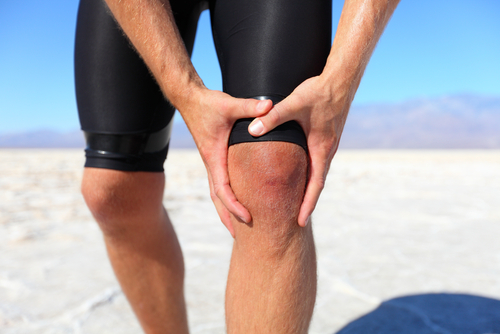Cycling is relatively easy on your knees. There is no impact and you move the joint, keeping it in good condition. It is refuge for athletes that developed bad knees in other sports. That said, you still have to be careful with your knees and listen to them when cycling as knee pain causes can range from bike fit to previous issues.
Preventative Knee Care
As always, avoiding injury is the best way to deal with any potential injuries. Despite the large load knees carry, they are fragile if used improperly. For starters, they only bend on one plane, and with a limited range. Try not to strain ligaments by twisting your knees or spending extended time at the limits of flexion or extension. Think of standing with knees locked or squatting like a baseball catcher giving signs before the pitcher delivers.
Second, they do not have very much insulation. When you are riding and it is fifty to sixty degrees Fahrenheit or below, cover them. You can cover them with knee warmers, leg warmers, or tights. You should also do a warmup before going into any big efforts to get maximal blood flow to warm your knees. Embrocation will not help; it only gives the illusion of feeling warm. It does this by irritating the skin and bringing blood to the surface. There is no temperature change at the crucial ligaments.
Bike fit is important to ensure knees track on the correct plane without any undue strain. There are many factors of bike fit that can impact knees – seat height, seat fore-aft position, sit bone support of the saddle, leg length discrepancy, cleat position, and cleat float. Small changes in these positions can influence how your knees feel while riding. The right position will put your body in the right position to produce power and keep your body in proper alignment.
Knee Pain Causes
Knee pain causes can strike a lot of people at different times. If you have chronic pain that makes riding unenjoyable, you need to figure out what is causing your pain. Craig Abrams, DC says, “Knee pain comes from hip and glute dysfunction until proven otherwise.” Think of the placement of the knees in body, and think of your body as a funnel. Any movement up above your knees will eventually have an effect on your knees and the biggest influencers are the large complex of bone and muscle at your hips and glutes. Bike fit and core strength are therefore the two biggest influences on knee pain while cycling.
Below are the easier problems to diagnose. If your pain continues after making the recommended adjustments, seek out a professional to examine your knee. Remember that you not only have to examine the pain at the immediate area of the knee, but also your overall fitness, core and otherwise, and also bike fit.
Pain on the Outside of the Knee
Pain on the outside of the knee is often the result of a saddle that is too high. It is the result of overextending the ligaments on the outside of the knee. The fix is easy; lower your saddle. Do it incrementally. Dramatic changes can result in other problems arising. Think about what caused the pain here. It is not the knee itself, but your hip position relative to your knee.
Pain on the Inside of the Knee
As you may have guessed, pain on the inside of the knee is often the result of a saddle that is too low. It requires more force from the complex of ligaments on the inside than they should be putting out, causing pain. The same applies from pain on the outside of the knee, but in reverse. Again, raise your saddle incrementally to control for any other issues that you may otherwise cause.
Pain on the Front of the Knee
Pain on the front of the knee is often tendonitis from doing too many or hard miles when your body is not prepared for them. The solution is dial back the volume and intensity until the pain subsides. Additionally, ride at lower force and higher cadence to reduce strain on the knee. The preventative measure is to gradually build to your fitness to get to a place where you can comfortably do big volume and intensity. Additionally, if your saddle is too low and/or too far forward, it can cause strain and thus pain at the front of the knee. Raise your saddle incrementally and also move it back if it’s too far forward. (See the Seat Setback section in How to Do a Proper Bike Fit)
Pain on the Back of the Knee
Pain behind the knee is often the result of your saddle being too high. This causes the back of your leg to have to over extend and when under pressure from trying to pedal, a lot of strain is placed up and down the back of your leg with the key pain point often being right behind the knee. Lower your saddle so you are not reaching for your pedals. Your legs should never be straight at the bottom of the pedal stroke.
Stay Away from Knee Pain Causes!
Knees are delicate and you should treat them accordingly. They do a huge amount of work that you may take for granted when they are healthy. If they suffer an injury, you will really know it. Preventative measures like regular stretching are best to stave off injury, but one day your knees may succumb. If they do, be prepared beforehand so you remedy the injury in the early stages.
